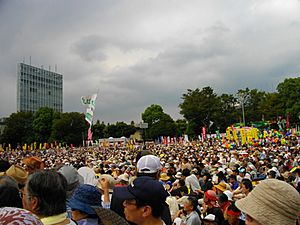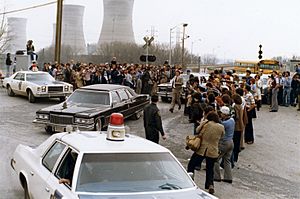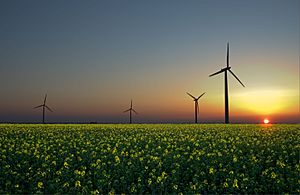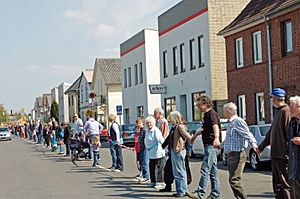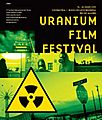Anti-nuclear movement facts for kids
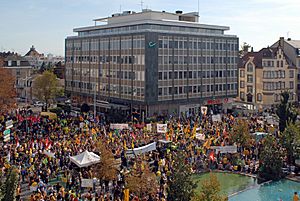
The anti-nuclear movement is made up of people who are against using nuclear power to make electricity. They often think nuclear power is too dangerous. They worry about the risk of a nuclear accident and believe that radioactive waste cannot be stored safely for a long time. Many also think that getting uranium (called uranium mining) and processing it is bad for the environment. After the nuclear accidents in Japan in 2011, many people around the world became more worried about nuclear power.
Contents
Why people are anti-nuclear
Concerns about nuclear power

Groups against nuclear power believe it can harm people and the environment. These worries include:
- Health problems and harm to the environment from getting and moving uranium.
- The worry that nuclear power could lead to more nuclear weapons.
- The big problem of safely storing nuclear waste for thousands of years.
- The chance of serious accidents happening.
People who are against nuclear energy often say that building nuclear power plants can help countries make nuclear weapons. They believe that the skills and equipment needed for nuclear power can also be used to create weapons.
Nuclear power plants are also very expensive to build. It's hard to guess the exact cost, but new plants in the USA can cost many billions of dollars. Building these plants is seen as a "risky business" by financial experts.
Anti-nuclear groups often talk about nuclear accidents to show how dangerous nuclear power can be.
- The most famous accident happened at the Chernobyl Nuclear Power Plant in Ukraine in 1986. A safety test went wrong, causing a huge explosion. This accident killed many people and caused billions of dollars in damage. Radioactive material spread far and wide, and hundreds of thousands of people had to move from their homes.
- Another serious accident was the Fukushima nuclear disaster in Japan in 2011. The cleanup from this accident is expected to cost over $100 billion and take 30 to 40 years.
Since the September 11 attacks, some people worry that terrorists could attack a nuclear plant. This could release dangerous radioactive material. Building more plants would mean more places that need to be protected.
There is a worldwide agreement that used nuclear fuel should be stored deep underground. However, no country has opened such a storage site yet. For example, the USA does not have a plan for long-term storage of its nuclear waste.
Nuclear-free choices
Groups against nuclear power often say that we can use less nuclear energy by saving energy and using it more wisely.
- Energy conservation means using less energy overall.
- Energy efficiency means getting the same amount of work done with less energy.
Anti-nuclear groups also support using renewable energy. This includes power from:
- Wind power
- Solar power
- Geothermal energy (heat from inside the Earth)
- Biofuel (fuel made from plants)
These renewable energy sources help make sure the world has enough energy and also reduce pollution that causes climate change.
Actions in different countries
Australia
Australia does not have any nuclear power stations. The government and the Green party are against nuclear power for Australia. However, Australia does have a small research reactor and sells uranium to other countries. Australia has a lot of the world's known uranium. The debate about uranium mining and nuclear issues has been going on for a long time in Australia, starting in the 1970s.
France
In the 1970s, a strong anti-nuclear movement grew in France. Many large protests and demonstrations took place. More recently, groups like Greenpeace have continued to campaign.
Germany
Germany has a long history of anti-nuclear protests, starting in the early 1970s. Large demonstrations stopped the building of a nuclear plant in a town called Wyhl. This success inspired people across Germany and in other parts of Europe and North America to protest against nuclear power.
United Kingdom
In 2008, the UK government announced plans to build new nuclear power stations. The anti-nuclear movement in the UK has raised concerns about these plans. People are also worried about the spread of nuclear weapons. Many groups and individuals have held protests over the years.
United States
For many years, the anti-nuclear movement in the United States was able to delay or stop the building of some new nuclear plants. Important anti-nuclear campaigns in the 1970s involved plants like Calvert Cliffs, Seabrook, and Diablo Canyon. The Three Mile Island accident also brought a lot of attention to the movement. More recently, protests have focused on specific power plants and nuclear waste sites.
More than fifty anti-nuclear groups have been active in the United States. Some well-known groups include Greenpeace USA and the Sierra Club. Many famous scientists and engineers have also shared their concerns about nuclear power.
Impact on popular culture
Starting in the 1960s, anti-nuclear ideas began to appear in movies and books. Some famous examples include the novel Fail-Safe and films like Dr. Strangelove or: How I Learned to Stop Worrying and Love the Bomb (1964), The China Syndrome (1979), Silkwood (1983), and The Rainbow Warrior (1992).
Recent developments
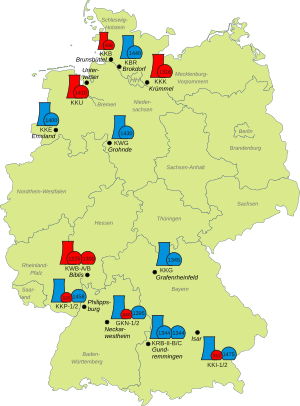
In April 2010, many environmental groups asked the United States Nuclear Regulatory Commission to check for problems in a new reactor design.
Also in April 2010, about 120,000 people in Germany formed a human chain between two nuclear plants. They were protesting against the German government's plans to keep nuclear power plants running longer.
In May 2010, about 25,000 people, including peace groups and survivors of the 1945 atomic bombs, marched in New York. They called for an end to nuclear weapons.
In September 2010, the German government changed its mind and decided to support nuclear energy again. This led to new anti-nuclear protests. Tens of thousands of Germans protested near Chancellor Angela Merkel’s office. Organizers said it was the biggest protest of its kind since the Chernobyl disaster in 1986.
In October 2010, tens of thousands of people protested in Munich, Germany, against the government's nuclear power plans. This was the largest anti-nuclear event in that region in over twenty years.
In November 2010, there were strong protests in Germany against a train carrying nuclear waste. Thousands of police officers were there to manage the protests.
In December 2010, about 10,000 people in India protested against the planned Jaitapur Nuclear Power Project. This project would be one of the world's largest nuclear power complexes.
In January 2011, five young Japanese people went on a hunger strike for over a week. They were protesting against the building of a new nuclear power plant near a sensitive natural area.
After the Fukushima Daiichi Nuclear Power Plant accidents in Japan in March 2011, protests against nuclear power grew stronger in Germany.
- On March 12, 60,000 Germans formed a 45-kilometer human chain between a city and a power plant.
- On March 14, 110,000 people protested in 450 other German towns. Polls showed that 80% of Germans were against the government's plan to extend nuclear power.
- On March 15, Angela Merkel said that seven older nuclear power plants would be temporarily closed. This time would be used to study how to switch to renewable energy faster.
In March 2011, about 2,000 anti-nuclear protesters in Taiwan demanded an end to the building of the island's fourth nuclear power plant. They also opposed plans to keep three existing plants running longer.
Also in March 2011, over 200,000 people took part in anti-nuclear protests in four large German cities. Organizers called it the biggest anti-nuclear demonstration the country had ever seen.
After the Fukushima accidents, environmental activists at a U.N. meeting in April 2011 asked for bigger steps to use renewable energy. They said this would help the world avoid choosing between the dangers of nuclear power and the problems of climate change.
In mid-April, 17,000 people protested against nuclear power in Tokyo.
In India, environmentalists, farmers, and fishermen have been protesting for months against the planned Jaitapur Nuclear Power Project. Protests became more intense after Japan's Fukushima disaster. In April 2011, a local man was killed and many were injured during violent protests.
Related pages
Images for kids
-
Women Strike for Peace during the Cuban Missile Crisis
-
Protest in Amsterdam against the nuclear arms race between the U.S./NATO and the Soviet Union, 1981
-
The 18,000 km2 expanse of the Semipalatinsk Test Site (indicated in red), which covers an area the size of Wales. The Soviet Union conducted 456 nuclear tests at Semipalatinsk from 1949 until 1989 with little regard for their effect on the local people or environment. The full impact of radiation exposure was hidden for many years by Soviet authorities and has only come to light since the test site closed in 1991.
-
Following the 2011 Japanese Fukushima nuclear disaster, authorities shut down the nation's 54 nuclear power plants. As of 2013, the Fukushima site remains highly radioactive, with some 160,000 evacuees still living in temporary housing, and some land will be unfarmable for centuries. The difficult cleanup job will take 40 or more years, and cost tens of billions of dollars.
-
Anti-nuclear protest on 14 Oktober, 1979 in Bonn, capital city of West Germany
-
The 150 MW Andasol Solar Power Station is a commercial parabolic trough solar thermal power plant, located in Spain. The Andasol plant uses tanks of molten salt to store solar energy so that it can continue generating electricity even when the sun isn't shining.
-
Members of Nevada Desert Experience hold a prayer vigil during the Easter period of 1982 at the entrance to the Nevada Test Site.
-
Demonstration in Lyon, France, in the 1980s against nuclear tests
-
A scene from the 2007 Stop EPR (European Pressurised Reactor) protest in Toulouse, France
-
Anti-nuclear demonstration in Munich, Germany, March 2011
-
U.S. President Barack Obama with Russian President Dmitry Medvedev after signing the New START treaty in Prague, 2010
See also
 In Spanish: Movimiento antinuclear para niños
In Spanish: Movimiento antinuclear para niños


